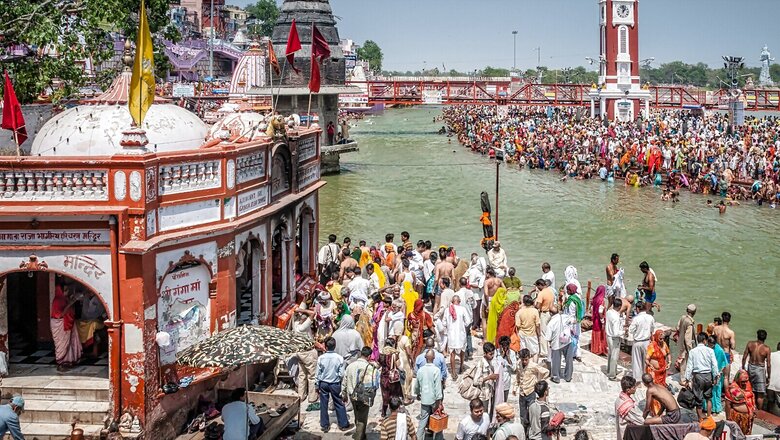
views
Policy Talk is a conversation with thought leaders, writers and policy practitioners. The objective is to have a discussion on current and future policies that will have an impact on us.
Professor Rajendra Pratap Gupta of World Intellectual Foundation, an author of four books on education, health and policy, spoke with K. Yatish Rajawat on a range of issues, including need for a cultural policy. Professor Gupta was also part of the committee that drafted the National Education Policy 2020.
Yatish Rajawat: You recently came out with a discussion paper on the culture policy of India. Tell us what is a cultural policy?
Rajendra Gupta: We have a Ministry of Culture. Why don’t we have a culture policy? To understand what a culture policy is, we first need to understand how we define culture. Culture includes the traditional indigenous knowledge, art, history, architecture, traditional sports, traditional medicine, heritage, beliefs, literature, customs, festivals, etc. It is actually the edifice on which a nation stands or a society stands. Culture tells you who we are, what we stand for, and what we believe in. So it is actually not just intangible, it’s much beyond that. Culture encompasses everything.
Yatish Rajawat: What should be the objective of a cultural policy?
Rajendra Gupta: Multiple objectives. First, I would like India to be the cultural capital of the world. In my paper, I have written what I call development of culture, development through culture, and cultural development. We are an aspirational country. We need to weave culture and development together. In fact, UNESCO’s Article 13 says you cannot have sustainable development without culture. We should learn from countries like Kenya, which say culture is one of the key aspects for sustainable development and poverty eradication. Culture is also a capital.
Yatish Rajawat: You have said that UNESCO has been saying since 2005 that every country needs to have a culture policy. Why do we not have one in spite of having a dedicated ministry?
Rajendra Gupta: A country that fights elections at different times all through the year, some topics become sensitive to the extent of being controversial. You avoid those. But I also feel perplexed: imagine if you were appointed the culture minister, how would you work without a vision for your ministry? Is it really possible to run a ministry without a vision? In constitutional debates, our first prime minister and K.T. Shah, a member of the Constituent Assembly, made a very strong case for a cultural policy. The Constitution makers were very clear about culture. K.T. Shah, on December 8, 1948, said we should couple the right to conserve culture to the right to develop culture. Now that itself was a very strong argument for a culture policy. Smaller countries and cities have a cultural policy, like city of Arras (France) and the city of Mississauga (Canada).
Yatish Rajawat: Should the policy be driven by the central government or should it be organically derived, districts upwards? In India, culture changes with each state.
Rajendra Gupta: I will quote Swami Vivekananda. He said European culture was predominantly material-driven. Greco-Roman was predominantly intellectual. Indian culture is predominantly spiritual. As a country, we stand for a culture that believes in Vasudhaiva Kutumbakam – the world is a family. You have rightly pointed that culture is geographical. But I have another interesting point here: the more we have moved away from our culture, our map has shrunk.
Yatish Rajawat: In the age of Internet and homogenisation, will we be able to influence the children of today and educate them about the culture of their past and what they should be concerned about in the future?
Rajendra Gupta: In this material world, we are all passing through a stage that I call zooming out. We are now entering the metaverse age. And, culture is our root. If the tree has strong roots, winds cannot uproot it otherwise, I think we will forget what we stand for. You see a Japanese in any part of the world, they still bow before people as a sign of respect; we forgot to do namaste.
Let me give you the other side. India has the largest diaspora in the world, across 210 countries. Their number stands at 18 million. Without culture, is there any other way to connect the diaspora?
Yatish Rajawat: Implementing a policy needs financial support. Where will the funding for a cultural policy come from?
Rajendra Gupta: We spend currently Rs 19 per head on culture, which is the lowest. A country like the US spends $6. Ireland, a much smaller country, spends $69. If culture as a sector is the largest contributor to jobs — the Indian government data says 45-47 per cent of all jobs come from the culture and creative industry — I see no reason why you should not step up your funding.
Yatish Rajawat: Most states have tourism policy and some revise them every five years. Do you think every state should make culture the starting point for their tourism policy?
Rajendra Gupta: According to the World Tourism Organisation, 37 per cent of all tourism is culture-related. If you look at tourism in India, it created 39 million jobs in 2019-20, which was 8 per cent of the total employment figures. Kumbh Mela is a big draw for tourists. The 2019 Kumbh Mela in Prayagraj generated Rs 1.2 lakh crore in revenue. The government had invested Rs 4,200 crore. So, cultural resources are also economic resources.
Yatish Rajawat: You said tourism policy should be a subset of culture policy. But shouldn’t culture be a subset of tourism policy?
Rajendra Gupta: My point is that culture should be an integral part of tourism policy. Four out of 10 tourists visit a country because they are drawn by its culture, as per World Tourism Organisation data.
Yatish Rajawat: When we talk about culture, it is immediately connected to the religious identity of a people. Amid a majority versus minority debate, do you think a culture policy will become a new battleground for the Left-secularist to reassert the fear that instead of pluralisation of culture, a policy will further lead to polarisation?
Rajendra Gupta: Culture and religion are two different things – let’s not merge them. India is multidimensional in culture. How many religions have come from India? Sikhism, Buddhism, Hinduism. Religion is an important aspect of culture, but we are pluralistic as a culture. Only those who fight elections are keen on making this an issue.
On the world UNESCO heritage list, India is sixth. The countries placed before us are Italy with probably 59 sites, China with 58, followed by Germany, Spain and France and then comes India with 40 sites. And do you know how many heritage and art sites we have? 500,000. If we had a policy, we would have made a concerted effort to be the number one.
Yatish Rajawat: We have a ministry for every industry, but we don’t have an industry for the creative economy, which is closely linked to the cultural economy of the country. We talk about it so often, but unfortunately we don’t have a policy around it. Why?
Rajendra Gupta: We are actually apologetic about our culture. That’s the sad part. I am not saying we become ultra-nationalists, but we should be proud of our heritage. During the first wave of COVID-19, everyone in the world was doing namaste. We should be proud of our culture, but for that, we need to know our culture.
Ghana, with a population of 3.7 crore, has a culture policy, which says: “We will keep assessment of local cultural things and international and see they are not inimical to our own.” Can a country as big as India dare to write that? We will think twice. Small countries like Barbados, Kenya have a culture policy.
Listen to the podcast here.
Read the full transcript here.
Read all the Latest Opinions here



















Comments
0 comment